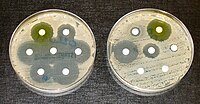
Photo from wikipedia
Infectious diseases remain significant health concerns worldwide, and resistance is particularly common in patients with tuberculosis caused by Mycobacterium tuberculosis. The development of anti-infectives with novel modes of action may… Click to show full abstract
Infectious diseases remain significant health concerns worldwide, and resistance is particularly common in patients with tuberculosis caused by Mycobacterium tuberculosis. The development of anti-infectives with novel modes of action may help overcome resistance. In this regard, membrane-active agents, which modulate membrane components essential for the survival of pathogens, present attractive antimicrobial agents. Key advantages of membrane-active compounds include their ability to target slow-growing or dormant bacteria and their favorable pharmacokinetics. Here, we comprehensively review recent advances in the development of membrane-active chemotypes that target mycobacterial membranes and discuss clinically relevant membrane-active antibacterial agents that have shown promise in counteracting bacterial infections. We discuss the relationship between the membrane properties and the synthetic requirements within the chemical scaffold, as well as the limitations of current membrane-active chemotypes. This review will lay the chemical groundwork for the development of membrane-active antituberculosis agents and will foster the discovery of more effective antitubercular agents.
Journal Title: Journal of medicinal chemistry
Year Published: 2022
Link to full text (if available)
Share on Social Media: Sign Up to like & get
recommendations!